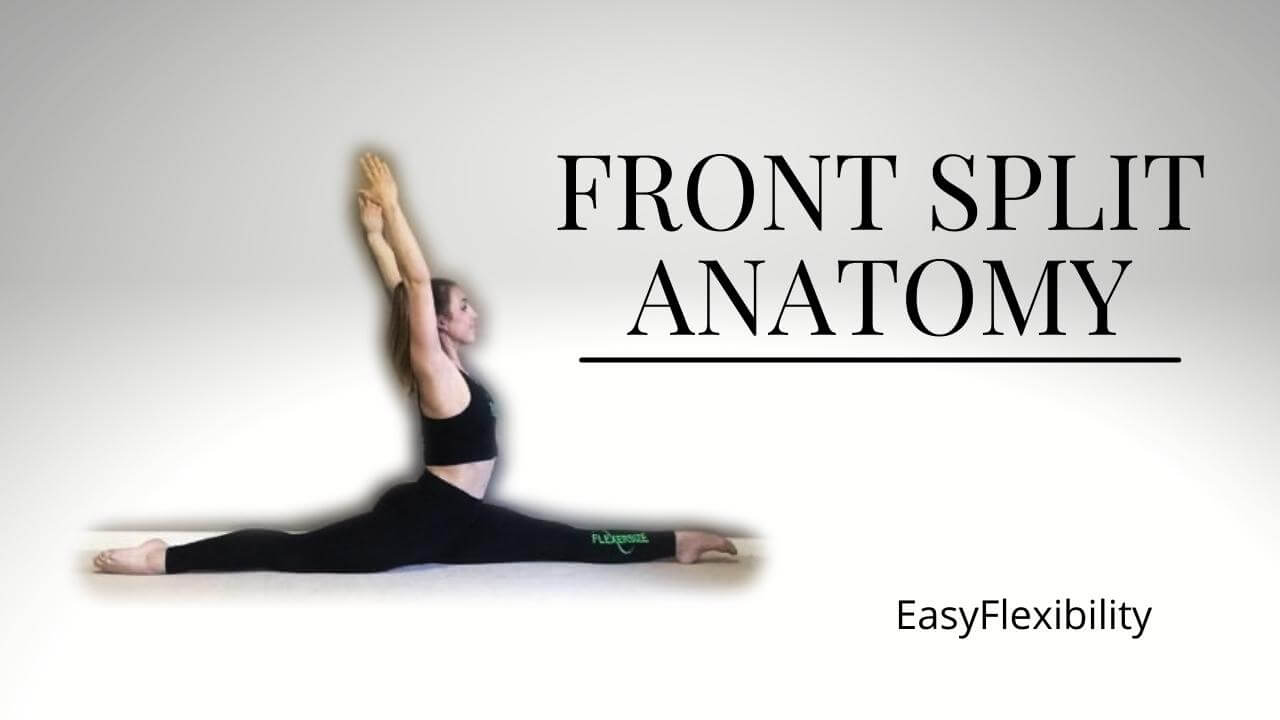Front Split Anatomy: Before going into the details of Front Split, you must understand what’s a “Split”. A Split is a physical position in which the lower limbs are in line to one another but are extended in opposite directions.
There are mainly two varieties of splits that are Side Splits and Front Splits. A Front Split also known as “Hanumanasana” is done by placing the legs such way that one leg is anteriorly placed and the other lies posteriorly but are still in line with each other while the hips remain squared.
There are further types of Front Split, like True Front Split and Open Front Split. (Difference between the two is present on www.elasticsteel.com).
The type we will discuss here or take as a reference is True Front Split variation. Most of the people who try this variation face difficulty in executing it. The reason is lack of flexibility and strength of some important muscles that we are going to discuss.
Let’s start with the anatomy behind the Front Split.
Muscles Lengthening (Front Leg)
Hamstrings:

Hamstrings is a group of three muscles helps in knee flexion and hip extension. During a Front Split, the front leg is flexed at the hip joint and the Hamstrings are lengthened. This is why, the flexibility of Hamstrings is important.
Gluteus Maximus:

It is also an extensor of the hip joint hence it is also being stretched during a Front Split and if it has low flexibility, it restricts the front leg.
Gluteus Medius (Posterior Fibers):

The posterior fibers of Gluteus Medius contract to produce hip extension. This means these fibers are also stretching during the flexion of anteriorly placed leg. Thus, requires flexibility.
Adductor Magnus (Ischial Fibers):

The ischial part of Adductor Magnus is considered the Hamstring portion and also resists the flexing thigh as it is an extensor of the hip so flexibility of this muscle is also crucial.
Piriformis:

Piriformis is an abductor and extensor of the hip. It is also stretched during the Front Split thus its flexibility is also a must.
Calf Muscles:

Calf Muscles are plantar flexors of the foot. As you can see, the front foot is dorsiflexed. This means that Calf Muscles are being lengthened and hence require flexibility.
Plantaris:

It is a weak plantar flexor of the foot and gets stretched while executing the Front Split.
Popliteus:

Popliteus is a small muscle that initiates the knee flexion. But in the extending position of the front leg, it gets stretched.
Muscles Lengthening (Rear Leg)
Psoas Major:

Psoas Major muscle is a major flexor of hip joint. In the rear leg, the hip joint is hyperextended so here the Psoas Major is getting stretched.
Iliacus:

Iliacus works with Psoas muscle in flexing the hip joint and we know the rear leg is definitely not flexing, actually it’s the opposite. Thus Iliacus requires flexibility.
Tensor Fascia Lata:

Tensor Fascia Lata apart from being an abductor of the leg, is also a flexor of the hip and gets stretched the same way in the rear leg like other flexors of the hip and requires flexibility.
Rectus Femoris:

Rectus Femoris also flexes the thigh at the hip and same applies on it.
Pectineus:

Being the most anterior adductor of the hip, Pectineus can also flex the hip. During the hyperextension of rear leg as in the Front Split, it is stretched.
Sartorius:

Sartorius is a unique muscle, not only can it flex the hip but also the knee. So, in the rear leg it will be stretched as other hip flexors.
Adductor Magnus (upper part):

The upper part of Adductor Magnus is devoted to flex the hip. So, it is stretching here and requires flexibility so that it doesn’t resist the Front Split.
Adductor Longus:

Just like Adductor Magnus, Adductor Longus also participates in flexion of thigh in addition to adduction and getting stretched in the rear leg.
Adductor Brevis:

Adductor Brevis is an adductor as well as a hip flexor. It will be stretched as well. Its flexibility is important too.
Gracilis:

Although, hip flexion is the primary action of Gracilis, but it does participate in hip flexion and will be stretched during the hyperextension of the hip.
Muscles Lengthening (Core)
Psoas Minor:

Psoas Minor is a weak flexor of the Trunk. In Hanumanasana, the trunk has to extend backwards during which trunk flexors including Psoas Minor, stretch and if flexibility is not their, this can lead to hinderance in Trunk extension.
External Oblique Front Split Anatomy:

External Obliques are prime flexors of the Trunk. They will be stretched during the Front Split leading to extension of the Trunk. Their flexibility is important.
Internal Oblique Front Split Anatomy:

Another flexor of the trunk that is lengthening here.
Muscle Contracting (Core)
Spinal Extensors Front Split Anatomy:

Spinal Extensors do the same as what their name suggests i.e. extend the spine. They contract during the Front Split hence require strength.
Quadratus Lumborum Front Split Anatomy:

Quadratus Lumborum has a role in extending the lumbar vertebrae. It contracts while executing the Front Split like the one in the picture. Strengthening it will definitely help.
We’ll show you how to achieve a True Front Split Fast, Safe and Easy! Our programs are scientifically based and created by a world renowned fitness & flexibility expert Paul Zaichik.
Click on the picture below to start today!



3 responses to “Front Split Anatomy: How to Do the Splits, Training Tips”
[…] Recommended: Front Split […]
[…] upside down, etc.), we are just going to focus on the actions of the back, shoulders, and front body. Let’s first break down the muscles used to achieve this […]
[…] can do one type of split: In previous blogs we have talked about Front to Side Split carry over (or lack of it). We also talked about different types of forward splits and their […]